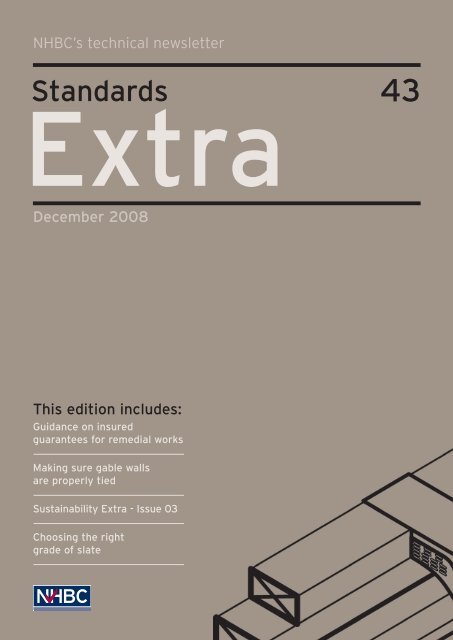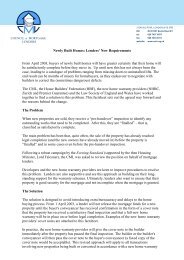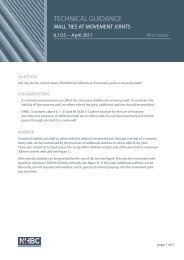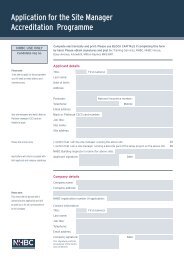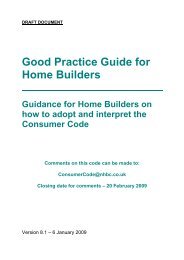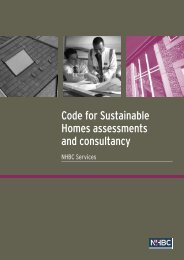Standards Extra - NHBC Home
Standards Extra - NHBC Home
Standards Extra - NHBC Home
You also want an ePaper? Increase the reach of your titles
YUMPU automatically turns print PDFs into web optimized ePapers that Google loves.
<strong>NHBC</strong>’s technical newsletter<br />
<strong>Standards</strong><br />
<strong>Extra</strong> 43<br />
December 2008<br />
This edition includes:<br />
Guidance on insured<br />
guarantees for remedial works<br />
Making sure gable walls<br />
are properly tied<br />
Sustainability <strong>Extra</strong> - Issue 03<br />
Choosing the right<br />
grade of slate
<strong>Standards</strong><br />
<strong>Extra</strong><br />
CONTENTS<br />
2/3<br />
<strong>NHBC</strong> <strong>Standards</strong><br />
for Conversions<br />
and Renovations -<br />
Insured Guarantees<br />
3<br />
Showerheads<br />
over baths<br />
4<br />
Closed or<br />
mothballed sites<br />
5<br />
Gable walls -<br />
the importance<br />
of restraint<br />
6<br />
Slates -<br />
no more grey areas<br />
7<br />
Secure escape<br />
8<br />
Cast stone to<br />
be recognised in<br />
<strong>NHBC</strong> <strong>Standards</strong><br />
8<br />
Questions<br />
and answers<br />
<strong>NHBC</strong> <strong>Standards</strong><br />
for Conversions<br />
and Renovations –<br />
Insured Guarantees<br />
In <strong>Standards</strong> <strong>Extra</strong> issue 32<br />
(April 2005) we took a look<br />
at the updated <strong>Standards</strong> for<br />
Conversions and Renovations<br />
that became effective in<br />
September 2005.<br />
Since that time the <strong>Standards</strong> have<br />
provided an integral part of <strong>NHBC</strong>’s risk<br />
management of such projects. However,<br />
we continue to receive a number of<br />
enquiries about the part of the Standard<br />
that deals with insured guarantees/<br />
warranties for specialist remedial works.<br />
Those who regularly use the <strong>Standards</strong> for<br />
Conversions and Renovations will know<br />
that Clause C5 sets out our requirements<br />
for insured guarantees/warranties.<br />
The following text is extracted<br />
from that Clause:<br />
“Proprietary remedial treatment relating<br />
to wood rot, beetle infestation, dampproofing,<br />
structural waterproofing<br />
(tanking), wall tie replacement and other<br />
specialist work shall be the subject of a<br />
suitable insured guarantee/warranty”.<br />
The clause goes on to require that<br />
the guarantee/warranty should:<br />
■ be provided by the<br />
specialist contractor<br />
■ cover any failure of the work<br />
■ cover any consequent opening<br />
up and making good<br />
■ remain valid for a minimum<br />
period of 20 years<br />
■ be in favour of the home owner<br />
(provided it is automatically<br />
transferred at no cost to<br />
subsequent owners) and <strong>NHBC</strong>.<br />
Finally Clause C5 requires that:<br />
■ ”the specialist contractor’s obligations<br />
should be covered by an insurance<br />
policy issued by a UK regulated and<br />
authorised insurer, which includes<br />
cover against the specialist contractors<br />
insolvency and that the insurance policy<br />
should specify the property covered”.<br />
A typical conversion project<br />
2
Issue 42<br />
September 2008<br />
Problems<br />
Remedial works in progress<br />
Clauses C6, C9 and C13 of the<br />
<strong>Standards</strong> go on to confirm that:<br />
“Members of The Property Care<br />
Association (PCA), a division of the British<br />
Wood Preserving and Damp-proofing<br />
Association (BWPDA) backed by the<br />
Guarantee Protection Insurance Ltd (GPI)<br />
meet the requirements of Clause C6”<br />
During the last 3 years we have<br />
received contact from a number of<br />
other contractors and some insurers<br />
asking if <strong>NHBC</strong> would consider<br />
alternatives. But, disappointingly on<br />
reviewing their schemes we found<br />
that none fully met the level of cover<br />
required in the <strong>Standards</strong> or that<br />
provided by the PCA/GPI scheme.<br />
Claims spend on converted or<br />
renovated homes continues to be<br />
disproportionately high when compared<br />
with new build. The above images show<br />
just what can go wrong with specialist<br />
works! So making sure that insured<br />
guarantees/warranties are set up<br />
correctly to provide adequate cover for<br />
homebuyers, builders and <strong>NHBC</strong> when<br />
things do go wrong is imperative.<br />
In April this year we carried out an<br />
exercise to review the various alternative<br />
insured guarantee/warranty schemes<br />
known to us, by inviting some 30 or so<br />
specialist contractors and insurers to<br />
complete a detailed questionnaire. We<br />
askedthemtoconfirmthelevelofcover<br />
their scheme provided and importantly<br />
whether, in their view, this complied<br />
in full with the <strong>NHBC</strong> <strong>Standards</strong> for<br />
Conversions and Renovations. Following<br />
a thorough review of the 20 or so<br />
contractors and 3 insurers who<br />
responded, we were not able to identify<br />
any companies who matched (or bettered)<br />
the cover needed to meet our current<br />
requirements, other than PCA/GPI.<br />
However, a recent submission from<br />
Construction Guarantee Services<br />
Ltd (CGS) was found to also meet our<br />
requirements. CGS require their<br />
contractors/members to meet with<br />
the Accredited Wykamol User Scheme<br />
requirements as a benchmark for technical<br />
competence, and also that CGS perform<br />
an ongoing vetting process broadly<br />
in line with our requirements.<br />
We have also established that the CGS<br />
guarantee/warranty is backed by Milburn<br />
Insurance Company Ltd and this meets<br />
our requirements for insurance. We have<br />
therefore agreed that a CGS contractor/<br />
member backed by Milburn Insurance<br />
canbeconsideredasanacceptable<br />
alternative to the PCA/GPI cover.<br />
Naturally, we feel that competition in<br />
this area is extremely important and<br />
therefore should any other insurers or<br />
contractors come forward with schemes<br />
that comply in full with our <strong>Standards</strong><br />
for Conversions and Renovations we<br />
would be pleased to include them as<br />
an acceptable alternative.<br />
ACTION<br />
If you intend to engage<br />
specialist contractors<br />
to carry out any of the<br />
remedial work detailed on<br />
page 2, make sure they can<br />
provide a suitable insured<br />
guarantee/warranty that<br />
is acceptable to <strong>NHBC</strong>.<br />
Showerheads over baths<br />
Where builders provide a showerhead over a bath<br />
dotheyneedtoprovideascreenandtilethewalls?<br />
This long running issue has now been resolved by <strong>NHBC</strong>’s<br />
<strong>Standards</strong> Committee who consider it reasonable that water should<br />
be contained (and not go over the bathroom floor) and the walls<br />
around the bath should be tiled where water will fall on them.<br />
Where builders provide a showerhead over a bath, or the<br />
fixing for a showerhead such that people can stand under it,<br />
then builders will be required to provide a screen or other<br />
suitable means to contain the water.<br />
Additionally the surfaces that may be wetted by persons<br />
using the shower facility will need to be tiled or have an<br />
equally water resistant finish.<br />
This is nothing more than most builders already provide but it<br />
will be incorporated into <strong>NHBC</strong> <strong>Standards</strong> at the next reprint.<br />
ACTION<br />
Builders are asked to note that this will be<br />
incorporated into the <strong>Standards</strong> in due course.<br />
Where BI’s come across this scenario in the interim<br />
the builder will be advised of the forthcoming change<br />
and asked to comply with the new requirements. This<br />
will be noted as an observation in the Site Record Book.<br />
3
<strong>Standards</strong><br />
<strong>Extra</strong><br />
Closed or mothballed sites<br />
The current downturn in construction activity is resulting<br />
in a number of sites and plots being closed or mothballed.<br />
Past experience shows that where this<br />
has not been done correctly, it has resulted<br />
in substantial future claims costs for<br />
both builders/developers and <strong>NHBC</strong>.<br />
At any stage of construction it is<br />
vitally important that appropriate<br />
precautions are taken to ensure<br />
the durability and likely in-service<br />
performance of materials, products and<br />
systems is not impaired by the process<br />
of being closed or mothballed. To ensure<br />
potential issues are fully considered<br />
builders/developers should produce a<br />
practical site closure plan. The plan<br />
should consider the following aspects:<br />
Foundations and substructure<br />
Where plots are closed just after the<br />
foundations have been installed action<br />
should be taken to provide protection<br />
to ensure that rain, ground water,<br />
drying weather and frost cannot<br />
adversely affect the foundations.<br />
Where specialist foundations and<br />
ground treatment have been employed<br />
and left exposed the designer should<br />
be consulted for advice.<br />
Weatherproofing<br />
Where possible, dwellings should be<br />
made fully weathertight. Where this is<br />
not achievable cavities should be closed<br />
to avoid water and debris accumulating<br />
andtoprotectanycavityfillalreadyin<br />
place. The protection of exposed<br />
timbers including all types of sheathing,<br />
plywood, flooring elements, joists, and<br />
roof members is also very important.<br />
Particular attention should be given<br />
to timber frame construction and the<br />
possible problems associated with<br />
increased moisture content of the<br />
4<br />
A mothballed site<br />
timber over long periods. Temporary<br />
sealing of openings in the envelope will<br />
be required for both weatherproofing<br />
and security. Additional items to be<br />
considered include the provision<br />
of temporary sealing to prevent<br />
infestation by insects and rodents.<br />
Ventilation<br />
Where plots are closed it is very<br />
important to ensure adequate<br />
ventilation is provided to prevent<br />
possible fungal attack and mould<br />
growth to floors, walls, roofs, ceilings,<br />
fixtures and fitments.<br />
UV degradation<br />
Materials that may be adversely<br />
affected by the effects of solar UV<br />
should be protected to avoid premature<br />
degradation. Materials could include<br />
dpm’s, dpc’s and roofing felts (including<br />
vapour permeable underlays) which<br />
would normally be covered.<br />
Drainage<br />
Plots that have completed roof<br />
coverings in place should also have<br />
all rainwater guttering and downpipes<br />
completed and connected to a suitable<br />
outfall to prevent the possibility of<br />
damage caused by excess water<br />
running over external walls etc.<br />
Site security<br />
You must be mindful of any health<br />
and safety risks presented by the<br />
vacant site. The Principal Contractor<br />
maintains a liability for the safety of<br />
anyone on the site regardless of<br />
whether or not they are lawfully there.<br />
Because of this, it is important to leave<br />
thesiteinassafeastateaspossible<br />
as well as taking measures to prevent<br />
access to the site.<br />
Fencing should be continuous around<br />
the site and panels should be of the<br />
anti-climb type and double clipped to<br />
make access difficult. Where the risk of<br />
intruders is high a solid hoarding with<br />
furthersecuritymeasuresmaybe<br />
appropriate. On site you should make<br />
sure any structures are safe and if<br />
possible remove all scaffolding from the<br />
site. If scaffolding remains make sure all<br />
ladders are removed, or locked out of<br />
sight. No excavations and manholes<br />
should be left open. Securely covering<br />
manholes and filling excavations is ideal,<br />
but if this is not possible, openings<br />
should be adequately fenced off.<br />
Ensure any plant is removed from site<br />
or locked securely in the compound if<br />
removal isn’t practical. Ideally materials<br />
left on site should be kept to a minimum,<br />
whatever is left on site should be stacked<br />
safely within a storage compound or<br />
locked in storage containers.<br />
Even when the site has been<br />
mothballed it is still the Principal<br />
Contractors responsibility and regular<br />
checksmustbemadetoensurethe<br />
perimeter is secure and to check for<br />
any signs of trespass or damage.<br />
Storage<br />
It is important that materials and<br />
products are correctly stored in an<br />
appropriate manner to ensure their<br />
durability and design life is not<br />
compromised and to ensure Health<br />
and Safety and security issues<br />
mentioned above are addressed.<br />
Inspection<br />
<strong>NHBC</strong> staff (normally Building Inspectors)<br />
will advise builders/developers of the<br />
precautions to be taken when sites<br />
and plots are closed or mothballed as<br />
detailed above. These are practical<br />
measures to mitigate damage to plots<br />
at all stages of construction ensuring<br />
that when work restarts damage is<br />
avoided or at the very least kept to<br />
a minimum.<br />
ACTION<br />
Where sites and plots<br />
are closed or mothballed<br />
an appropriate closure<br />
plan, taking account of the<br />
above, should be developed<br />
and implemented by<br />
builders/developers to<br />
reduce the risk of<br />
additional cost when<br />
work re-commences.
Issue 43<br />
December 2008<br />
Gable walls - the importance of restraint<br />
When the wind blows parallel to gable walls<br />
it generates negative pressures on them.<br />
If the gables are not adequately built and<br />
connected to the roof structure these<br />
negative pressures can ‘suck-out’ the gable<br />
walls resulting in catastrophic failure.<br />
This has occurred on a number of sites recently during<br />
high winds and has highlighted the importance for<br />
gables to be correctly constructed and restrained.<br />
The common practice of using trussed rafters leads to a<br />
situation where none of the roof self-weight (traditionally<br />
from purlins and binders) passes into the gable wall.<br />
With this form of construction the lateral restraint to the<br />
gable has to be provided by adequate strapping at the<br />
verge (or by a gable ladder) and at ceiling level if<br />
required (see strap location diagram). The restraint<br />
must be correctly detailed and installed.<br />
As well as providing lateral restraint to gable walls,<br />
strapping also contributes to the robustness of the<br />
building and reduces the sensitivity of the building to<br />
disproportionate collapse in the event of an accident.<br />
Restraint straps therefore provide a critical function.<br />
The following diagrams show an acceptable method<br />
of satisfying building regulations for residential dwellings<br />
not exceeding 3 storeys.<br />
Where these dwellings exceed 3 storeys and have<br />
been designed in accordance with BS5628-1:2005<br />
(Code of practice for the use of masonry) the connections<br />
to gable walls should be provided at intervals of not more<br />
that 1.25m centres for all storeys or as specifically<br />
required by the design engineer.<br />
Effective strapping at ceiling level<br />
Effective strapping at verge<br />
Strap location<br />
Ensure that:<br />
Collapsed gable wall<br />
ACTION<br />
The straps are installed and fixed fully in accordance with<br />
the building regulations guidance and in accordance<br />
with manufacturer’s and designer’s requirements.<br />
Rafters are not notched to make the straps flush with the rafter.<br />
The strap goes under the rafter and over ceiling joists.<br />
At the verge the strap turndown should be on a substantial<br />
piece of blockwork, preferably the centre of an uncut block.<br />
The strap should turn down vertically a minimum of 100mm<br />
and be tight against the face of the inner leaf wall.<br />
Packing should be provided, at the strap position,<br />
between the inner leaf and the first truss.<br />
Noggings (dwangs) are provided and set horizontal unless the<br />
strap has pre-formed twist to line it up with the roof slope.<br />
A high level of workmanship is maintained throughout the construction.<br />
5
<strong>Standards</strong><br />
<strong>Extra</strong><br />
Slates – no more grey areas<br />
For many years slate roofs have been<br />
acknowledged as the premier roof<br />
covering for pitched roofs but in recent<br />
times there have been concerns about the<br />
durability and appearance of certain slates.<br />
The change from the British Standard,<br />
BS 680 to European Standard BS EN<br />
12326-1 and -2 has resulted in a need<br />
for the user or specifier to specify what<br />
level of performance and durability they<br />
want. Whereas BS 680 gave a simple<br />
pass or fail for several tests and two<br />
quality ‘grades’ BS EN 12326 does not.<br />
Because of the wide range of qualities<br />
of slate which are acceptable throughout<br />
Europe, each with different durability, it<br />
provides a set of levels of performance<br />
against a series of tests. The user<br />
can and should choose what level of<br />
performance they want for each test.<br />
To address this issue <strong>NHBC</strong> has been<br />
working with the industry to establish what<br />
should be the minimum specification to<br />
meet with <strong>NHBC</strong> <strong>Standards</strong> to ensure<br />
the product has acceptable durability.<br />
Under BS EN 12326 consignments of slates<br />
should now have an “accompanying<br />
commercial document (ACD)” from the<br />
producer/supplier indicating the slate’s<br />
performance. An example of the full ACD,<br />
containing an explanation on the<br />
information it should provide, can be view<br />
at www.stoneroof.org.uk/tests2.html<br />
Below is an example of the first page of<br />
the ACD together with the level of test<br />
results that <strong>NHBC</strong> now looks for to<br />
meet our <strong>Standards</strong>.<br />
Accomanying commercial document -<br />
Information requirements<br />
Producer – Sufficient details are required<br />
to identify the producer/supplier.<br />
Number of this commercial document<br />
– This can be a number issued by the<br />
test house or the producer/supplier.<br />
Date of issue – The ACD should be<br />
relevant for the batch of slates being<br />
supplied. Retesting and updating of ACD’s<br />
should be carried out at least once a year<br />
and more frequently where large volumes<br />
of slates are being extracted and for every<br />
new source or vein of rock extracted.<br />
Commercial document issued by –<br />
this can be the test house or the<br />
producer/supplier.<br />
Location of mine or quarry –<br />
required for traceability of slate.<br />
Date of sampling & date of testing –<br />
If more than one date is applicable to<br />
sampling and testing they should be<br />
indicated against the individual test results.<br />
The sampling and testing dates should<br />
be as close as possible to the ‘Date of<br />
issue’ of the ACD. The ‘Date of issue’<br />
should be used to establish when further<br />
sampling and retesting is required at the<br />
frequencies set out in <strong>NHBC</strong> <strong>Standards</strong>.<br />
Product description & commercial name<br />
– Name or description given to slate<br />
by the producer/supplier.<br />
Dimensional tolerances – These are<br />
to be within those set down by the<br />
Standard. Note: Slates, which fall within<br />
the tolerances, still require proper<br />
selection and fixing on site to achieve<br />
an acceptable finished roof covering.<br />
Nominal thickness – Thickness of<br />
the roofing slates, as declared by<br />
manufacturer and the amount<br />
by which individual thickness varies as<br />
a percentage of the nominal thickness.<br />
Characteristic modulus of rupture (MoR)<br />
– a measure of the slate’s mechanical<br />
strength both along and across the slate.<br />
Slates from weaker rocks may need<br />
to be supplied thicker than those<br />
from stronger rocks to<br />
achieve a satisfactory<br />
performance in use.<br />
The Standard provides<br />
equations, which are<br />
used to establish the<br />
minimum slate thickness.<br />
The minimum thickness<br />
is calculated using the<br />
CMoR and a National<br />
(i.e. UK) factor, which<br />
takes into account the<br />
weather conditions of<br />
the country of use.<br />
It is the producer’s/<br />
supplier’s responsibility<br />
to ensure all the slates<br />
in a consignment are<br />
at least as thick as the<br />
minimum value obtained<br />
using the UK factor.<br />
Water absorption<br />
– For compliance with<br />
<strong>NHBC</strong> <strong>Standards</strong> the<br />
water absorption should<br />
be no greater than<br />
0.6% i.e. A1 code.<br />
Freeze thaw – This test is<br />
not required when slates<br />
have a ‘Water absorption’ no greater<br />
than 0.6%<br />
Thermal cycle – This is a test for<br />
reactive metallic minerals within the<br />
slate, which may cause staining, pitting<br />
and/or delamination and potential failure<br />
of the slate. For compliance with <strong>NHBC</strong><br />
<strong>Standards</strong> a slate should achieve a T1 code.<br />
Carbonate content – High carbonate<br />
content can cause colour changes in<br />
the slate and potential for accelerated<br />
erosion and break down. For compliance<br />
with <strong>NHBC</strong> <strong>Standards</strong> a slate should<br />
achieve a S1 code.<br />
Note: It is acknowledged that some slates,<br />
that do not achieve a S1 code, have a history<br />
of satisfactory performance for at least<br />
60 years in the UK. If such a slate is being<br />
considered please discuss its acceptance<br />
with <strong>NHBC</strong> Technical in the first instance.<br />
Non-carbonate carbon content – to meet<br />
the standard this should be less than 2%.<br />
Exposure to fire, reaction to fire<br />
& release of dangerous substances –<br />
Roofing slates meet these requirements.<br />
An abbreviated version of the ACD,<br />
as shown in BS EN 12326 should also<br />
be attached to each crate of slates.<br />
Accompanying commercial document<br />
ACTION<br />
Ensure that your slate supplier provides an<br />
accompanying commercial document with each<br />
consignment of slates, and check the slates<br />
have properties at least as good as those<br />
listed under information requirements above.<br />
6
Issue 43<br />
December 2008<br />
Secure escape<br />
In <strong>Standards</strong> <strong>Extra</strong> Issue 31 December 2004 we published<br />
an article about locks to individual flat entrance doors.<br />
The article explained the need to provide good security whilst<br />
still providing escape in the event of a fire without the need<br />
for a key i.e. keyless egress. Since that time <strong>NHBC</strong> has been<br />
working with representatives of the lock industry, police,<br />
insurers and the fire service in developing a suite of British<br />
<strong>Standards</strong> that cover security and means of escape for all<br />
types of dwellings.<br />
The first British Standard for locks, which addressed enhanced<br />
security for dwellings, was BS 3621 ‘Thief resistant lock assembly<br />
- Key egress’. The Standard covers single point locking<br />
operated by a key from both sides of a door. For locks which<br />
operate without the use of a key on the inside either via a<br />
thumb turn or handle, BS 8621 ‘Thief resistant lock assembly<br />
- Keyless egress’ was developed and published in 2004.<br />
BS 8621 locks provide keyless egress at all times but there<br />
may be times when it would be desirable to lock the internal<br />
thumb turn or handle when leaving a dwelling unoccupied.<br />
This feature is useful in preventing someone breaking in<br />
through a window and removing large items via the entrance<br />
door. To address this a further British Standard, BS 10621 ‘<br />
Thief resistant dual-mode lock assembly’ was developed and<br />
published in 2007. This lock has the facility to lock the<br />
internal thumb turn or handle by an extra operation of the<br />
key from the outside when leaving the property unoccupied.<br />
The latest editions of these three British <strong>Standards</strong> cover<br />
single point locks for all types of dwelling. In some cases it<br />
may be desirable to fit two locks to achieve sufficient<br />
resistance to forced entry and the recommended lock<br />
functions. An alternative would be to fit a multi-point lock,<br />
which has the same recommended lock functions.<br />
With different dwelling types it is important that the<br />
right lock(s) is fitted to ensure no one can accidentally<br />
become locked in or out of their own property. Below is<br />
a description of the lock functions that should be<br />
used in each dwelling type.<br />
Main entrance door<br />
Dwellings – All<br />
All entrance doors of individual dwellings should be<br />
fitted with one (or more) securely fixed lock and keep<br />
or multi-point locking system, which has:<br />
■ at least 1000 differs<br />
■ a fixing which, if burst open, would not pull<br />
out without breaking the door or its frame<br />
■ a hardened steel bolt or inserts to prevent sawing<br />
■ latch and deadlocking facility.<br />
Locking devices fitted to entrance doors should permit<br />
emergency egress without the use of a key when the<br />
dwelling is occupied.<br />
Any glazing which, if open or broken, would permit release<br />
of the thumb turn by hand or arm entry should be laminated.<br />
Dwellings - With an alternative means of escape.<br />
(These are typically houses with a front and rear door)<br />
Lock(s) should provide initial security by use of a latch<br />
operable with a key externally and a handle/thumb turn<br />
release internally. The full deadlocking facility should be<br />
engaged and be operable with a key externally and a<br />
handle/thumb turn release internally. Locks, which comply<br />
with BS 8621, meet these requirements. External handles<br />
on multi-point locking systems should be split spindle<br />
to avoid operating the latch.<br />
Enhanced security can also be achieved by providing the<br />
facility to deadlock the internal handle/thumb turn when<br />
leaving the dwelling un-occupied. Locks, which comply<br />
with BS 10621, meet these requirements.<br />
Dwellings - Without an alternative means of escape<br />
opening direct to outside. (These are typically ground<br />
floor flats or maisonettes)<br />
The door should be held close by use of a latch operable with<br />
a key externally and a handle/thumb turn release internally.<br />
The full deadlocking facility should be engaged and be<br />
operable with a key externally and a handle/thumb turn<br />
release internally. Locks, which comply with BS 8621, meet<br />
these requirements. External handles on multi-point locking<br />
systems should be split spindle to avoid operating the latch.<br />
Dwellings - Without an alternative means of escape<br />
opening onto a communal access. (These are typically<br />
flats accessed off a communal stairs)<br />
The door should be held close either on a latch operable<br />
with a handle both internally and externally or a roller bolt,<br />
so that the door cannot slam shut locking the homeowner out<br />
without a key. The full deadlocking facility should be engaged<br />
and be operable with a key externally and a handle/thumb<br />
turn release internally. Locks, which comply with BS 8621,<br />
meet these requirements.<br />
Secondary external access doors<br />
The door should be held closed on a latch and operable by<br />
use of a handle both internally and externally. A deadlocking<br />
facility should be operable by use of a key both internally<br />
and externally. Locks complying with BS 3621 meet these<br />
requirements. Alternatively a thumb turn may be used<br />
internally in place of a key operation. Locks complying with<br />
BS 8621 meet these re quirements. In addition bolts should<br />
be fixed securely at both top and bottom of the door on the<br />
internal opening edge. Where multi-point locking systems<br />
are used bolts may be omitted.<br />
ACTION<br />
When specifying door locks select the appropriate<br />
lock(s) that provides the recommended lock functions<br />
for the different dwelling types as stated above.<br />
7
<strong>Standards</strong><br />
<strong>Extra</strong><br />
Cast stone to be recognised<br />
in <strong>NHBC</strong> <strong>Standards</strong><br />
Over recent months <strong>NHBC</strong> has been considering how<br />
cast stone can be recognised in <strong>NHBC</strong> <strong>Standards</strong>.<br />
The 2008 revision of BS 1217 ‘Cast stone – specification’<br />
includes architectural dressings such as heads, cills,<br />
copings and string courses. It also includes cast stone<br />
ashlar masonry.<br />
The European Standard, BS EN 771-5 ‘Specification for<br />
masonry units. manufactured stone masonry units,’<br />
overlaps to cover cast stone ashlar masonry.<br />
The term cast stone has been used and is the correct<br />
description for reconstituted stone architectural dressings.<br />
ACTION<br />
The use of features made from cast stone<br />
should comply with the latest version of BS 1217.<br />
Better still, use the higher standards adopted by<br />
UKCSA members (as previously recommended in<br />
<strong>Standards</strong> <strong>Extra</strong> 36). Cast stone ashlar masonry<br />
can also comply with BS EN 771-5.<br />
QUESTIONS<br />
Q<br />
Slate hook fixings<br />
Is it acceptable to use slate<br />
hooks for fixing natural slates?<br />
A<br />
■<br />
■<br />
Roof fixings should be sufficient to resist the<br />
wind uplift forces and avoid slates blowing off or<br />
chattering on the roof. Fixings should also resist<br />
lateral dislodgement of the slates.<br />
Slate hook fixings come in two styles i.e. with a spike<br />
end for driving into the tiling batten or a hook-over end<br />
for hooking over a tiling batten. Both types are described<br />
in BS 5534 ‘Code of practice for slating and tiling’.<br />
Slate hooks<br />
■ Slates are fixed with only one hook placed centrally<br />
along the lower edge of the slate. <strong>NHBC</strong> <strong>Standards</strong><br />
clause 7.2 – S11(d) says slates should be fully nailed<br />
over the whole roof.<br />
No, the use of hook-over type slate hooks is not acceptable.<br />
However, spike-ended slate hooks may be acceptable<br />
providing they are minimum 2.7mm diameter stainless<br />
steel wire and can be shown to resist the wind uplift for<br />
the roof in question. The supplier should provide wind<br />
uplift figures for the roof and his fixings to show<br />
compliance, alternatively local examples of satisfactory<br />
use of the hook fixings could be considered.<br />
Slate hooks may be unsuitable for large slates which<br />
experience a greater wind uplift than smaller slates<br />
and for pitches above 75 degrees or below 25 degrees.<br />
Slate hooks are available with straight or crimped shanks.<br />
Crimped hooks reduce capillary action and should be<br />
used for roof pitches below 30 degrees.<br />
Slates at the perimeter of a roof e.g. eaves, valleys,<br />
verges, ridges, hips, abutments and penetrations<br />
should be nailed to resist uplift and lateral drift.<br />
<strong>NHBC</strong> <strong>Standards</strong> and Technical<br />
<strong>NHBC</strong> House, Davy Avenue, Knowlhill, Milton Keynes, Bucks, MK5 8FP<br />
Tel: 0844 633 1000 Fax: 0844 633 0022 www.nhbcbuilder.co.uk Email: technical@nhbc.co.uk<br />
8<br />
HB2467 12/08
Sustainability<br />
<strong>Extra</strong> 3<br />
December 2008<br />
Osborne achieves Code Level 5<br />
The Mid Street development in South Nutfield, Surrey,<br />
is the first habitable Code for Sustainable <strong>Home</strong>s Level 5<br />
affordable housing development in the UK. Built for the<br />
Raven Housing Trust, perhaps the most striking thing about<br />
these two flats is that, unlike most other homes built to high<br />
levels of the Code, they have a very traditional appearance,<br />
which hides the technology that lies under the skin.<br />
Over the last few years Osborne has invested<br />
considerably in developing the expertise needed to<br />
face the challenges of sustainable homes. Its approach<br />
is to consider sustainability from the inception of<br />
the project. The Osborne Demonstration House at the<br />
BRE Innovation Park was the first sustainable home<br />
to be built on the site and the lessons learned from its<br />
construction have been applied to Mid Street.<br />
It is worth noting that a particular additional challenge was<br />
that detailed planning consent had already been achieved<br />
prior to the decision being made to build to Code Level 5.<br />
Mid street development in South Nutfield<br />
Energy and CO2 emissions<br />
In order to achieve Level 5, close attention had to be<br />
paid to all categories of the Code, but the biggest<br />
challenges came from addressing the energy and<br />
emissions targets. Carbon dioxide emissions needed to<br />
be reduced by 100% and to achieve this, four guiding<br />
principles were set for the design:<br />
reducing energy demand<br />
maximising passive solar gain<br />
maximising the energy provided by renewable means<br />
minimising the use of fossil fuel.<br />
>>>
Sustainability<br />
<strong>Extra</strong><br />
Reducing energy demand<br />
A Structural Insulated Panel System<br />
(SIPS) was chosen to construct the<br />
walls of the homes. Wall panels<br />
comprise a ‘sandwich’ of two layers<br />
of 12mm oriented strand board and<br />
150mm high performance expanded<br />
polystyrene core. An additional layer<br />
of high performance expanded<br />
polystyrene insulation was provided<br />
externally to deliver a U-value of<br />
0.14W/m 2 K.<br />
Sealing tapes were applied at panel<br />
joints to control air leakage from the<br />
homes. Air leakage testing on<br />
completion confirmed extremely good<br />
performance of just 1m 3 /(hrm 2 ).<br />
Very high levels of thermal insulation<br />
were provided to the roof and floor<br />
and a mechanical ventilation system<br />
with heat recovery was fitted in order<br />
to minimise the amount of energy<br />
lost due to exhaust ventilation.<br />
Photovoltaic panels on used Mid street development<br />
Maximising passive solar gain<br />
The homes, which are orientated on the site to maximise<br />
passive solar gain, are fitted throughout with highperformance<br />
triple glazed windows. Window sizes were<br />
optimised to maximise passive solar gain and provide<br />
good levels of natural daylight inside the homes.<br />
Maximising the energy provided by<br />
renewable means and minimising the<br />
use of fossil fuel<br />
Space and hot water heating is provided by a shared<br />
biomass boiler, which uses wood pellets as its fuel<br />
source. There is a local supply of wood pellets and these<br />
are delivered by tanker and stored in an external store.<br />
The pellets are fed automatically to the boiler from the<br />
store by an auger.<br />
The boiler’s heat is stored in water in thermal stores<br />
fitted in each flat and is distributed on demand by means<br />
of an under floor heating system.<br />
A large array of photovoltaic roof panels provides<br />
electricity to the homes, and at times when the output<br />
exceeds the homes’ demand, the excess is exported to<br />
the National Grid. It is estimated that the array should<br />
produce approximately 900KWh per year.<br />
Water efficiency<br />
Essential Code credits were obtained through the<br />
installation of a rainwater harvesting system, which<br />
filters and collects water from the roof in a large<br />
underground storage tank. On demand, the stored<br />
rainwater is pumped to tanks in the roof and is fed down<br />
to supply WCs, washing machines and an outside tap.<br />
Combined with water efficient appliances – shallow<br />
baths, low flush WCs, aerated taps, plus digitally<br />
controlled showers the estimated consumption of each<br />
home will be 80 litres per person per day.<br />
Costs<br />
Osborne kept a close eye on costs at all stages of the<br />
development. They estimate the additional total cost to<br />
have been 24% (about £41,000 per home) compared with<br />
equivalent homes built to current Building Regulations<br />
standards. The highest expenditure items were:<br />
Photovoltaic panels £19,000<br />
Structural Insulated Panel System £12,800<br />
High performance triple glazed windows £7,000<br />
Rainwater harvesting system £6,500<br />
(these are total extra-over costs for both homes)<br />
Monitoring and feedback<br />
The Energy Saving Trust will monitor the energy usage of<br />
the Mid Street homes for a period of at least two years.<br />
This will include heat output, water consumption and the<br />
electricity generated from the photovoltaic roof panels.<br />
Early feedback does suggest that there have been a few<br />
teething problems as the residents get to grips with the<br />
operation of the heating and mechanical ventilation<br />
systems. Some technical problems have also been<br />
encountered with the inverters (used to convert the DC<br />
output from the photovoltaic panels into AC) tripping out.<br />
2
<strong>NHBC</strong> Foundation<br />
The <strong>NHBC</strong> Foundation’s latest reports cover<br />
two important topics – the management of<br />
construction site waste, and systemic failure in<br />
house building.<br />
‘Site waste management’ NF8<br />
The management of onsite waste is becoming increasingly important to the<br />
house-building industry. Not only is there a requirement to comply with<br />
environmental legislation (including The Site Waste Management Plans<br />
Regulations, which came into force in April 2008), but also to achieve cost<br />
savings by implementing good environmental practice.<br />
The construction industry uses an estimated 400 million tonnes of resources<br />
every year with 100 million tonnes ending up as waste. Construction projects<br />
involving multiple contractors can lead to confusion about who is responsible<br />
for environmental issues with implications for management of waste and<br />
disposal, licensing and permits, and working out who is responsible when<br />
things go wrong.<br />
In order to simplify the management of site waste, the <strong>NHBC</strong> Foundation and<br />
the Waste and Resources Action Programme (WRAP) funded research carried<br />
out by BRE to help the house-building industry write and implement site waste<br />
management plans (SWMPs) and recognise the associated benefits of putting<br />
these plans into practice.<br />
This guide provides the findings of this research as well as information on<br />
how waste created during the construction process can be managed more<br />
effectively as a result of writing and implementing a SWMP. It also provides a<br />
series of useful templates and checklists.<br />
‘Learning the lessons from systemic building failures’ NF10<br />
Throughout recent centuries there has been a gradual evolution of<br />
house-building practice and a continuous cycle of innovation. From time<br />
to time this innovation has inevitably given rise to unforeseen problems.<br />
Solutions have been found for these problems, lessons have been learnt<br />
and the industry has moved on.<br />
In parallel with the continuous innovation, there has been continuous<br />
refinement of building regulations, and our overall knowledge of what<br />
constitutes good practice has also developed.<br />
With innovative construction systems and materials, new detailing has to<br />
be developed that allows the particular design to be built. In many cases<br />
this leads to inadequate solutions, such as a reliance on sealants where,<br />
for example, a properly detailed flashing might be more appropriate.<br />
Although our overall knowledge has increased, it seems that our ability to<br />
pass that knowledge on to successive generations of professionals has<br />
diminished. This report reviews some historic problems for the benefit of<br />
today’s generation of professionals. It focuses on a number of systemic<br />
building failures that have come to light in various countries over the past<br />
30 years, including:<br />
failure of pre-cast reinforced concrete (PRC) houses in the UK<br />
moisture penetration of external insulation finish systems (EIFS) in<br />
British Columbia, Canada, the United States and New Zealand<br />
failure of structural insulated panel (SIP) roof systems in Alaska, USA.<br />
Site waste management report<br />
Systemic failure in<br />
house building report<br />
ACTION<br />
All <strong>NHBC</strong> Foundation<br />
reports can be downloaded<br />
at www.<strong>NHBC</strong>Foundation.org<br />
(click on ‘Projects’ tab to<br />
view all reports).<br />
3
Sustainability<br />
<strong>Extra</strong><br />
NEWS<br />
Department of Energy and Climate Change<br />
The new Department of Energy and Climate Change was created on 3 October 2008. Secretary<br />
of State, Ed Miliband, has committed the UK to cutting greenhouse gas emissions by 80% on<br />
1990 levels by 2050. In a wide-ranging Commons statement, Mr Miliband:<br />
backed the recommendations of Lord Turner's Climate Change Committee and said the<br />
Government would make the 80% reduction target binding in law by amending the Climate<br />
Change Bill currently going through Parliament.<br />
said that he plans to introduce a 'feed-in tariff' to support microgeneration and to make a<br />
further announcement soon on encouraging renewable heat. The use of feed-in tariffs in other<br />
countries, Germany in particular, has led to acceleration in the uptake of microgeneration.<br />
Ed Miliband<br />
Enhanced details<br />
The Energy Saving Trust’s Enhanced Construction Details (ECDs) focus on the issue of<br />
heat losses that occur at the junctions between building elements and around openings.<br />
Designed to help the construction industry achieve performance standards that exceed<br />
those set out in Building Regulations, they help developers and builders to meet the energy<br />
requirements of the Code for Sustainable <strong>Home</strong>s.<br />
Developed in association with an industry working group, these details improve on the<br />
performance delivered by the standard Accredited Construction Details (ACDs) and allow<br />
designers and builders to use a reduced thermal bridging y-value in SAP of 0.04 W/m 2 k.<br />
Enhanced construction<br />
details report<br />
Further information is available in the Building Professionals section of the EST website at<br />
www.energysavingtrust.org.uk/housing<br />
New CLG research on costs and<br />
benefits of zero carbon<br />
‘Research to Assess the Costs and Benefits of the Government’s Proposals to Reduce the<br />
Carbon Footprint of New Housing Development’ was published by CLG in September.<br />
Commissioned from Cyril Sweet, Faber Maunsell and Europe Economics, it supports the<br />
Regulatory Impact Assessment for the Building a Greener Future: Policy Statement published<br />
in July 2007.<br />
The report is an analysis of the costs and benefits of the proposed policy options for progressively<br />
enhancing Building Regulations (by 25% in 2010, 44% in 2013 and zero carbon from 2016).<br />
Zero carbon<br />
research report<br />
The report can be downloaded at:<br />
http://www.communities.gov.uk/publications/planningandbuilding/housingcarbonfootprint<br />
Review of the Code for Sustainable <strong>Home</strong>s<br />
The latest amendments to the technical guide to the Code came into effect on 3 November<br />
2008. The changes are generally minor in nature and correct or clarify the previous guidance.<br />
A review of the Code has recently commenced. Led by consultants, Faber Maunsell, the review<br />
will gather opinion on how the Code should evolve and <strong>NHBC</strong> will provide input to one or<br />
more of the review workshops. Topics specifically under scrutiny include energy (in the light<br />
of expected changes to Part L), the water calculator, ‘Lifetime <strong>Home</strong>s’ and adaptation to the<br />
effects of climate change.<br />
HB2450 12/08


